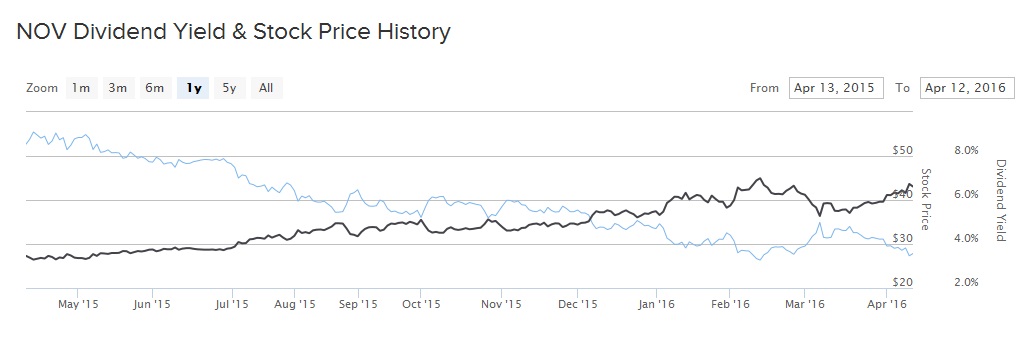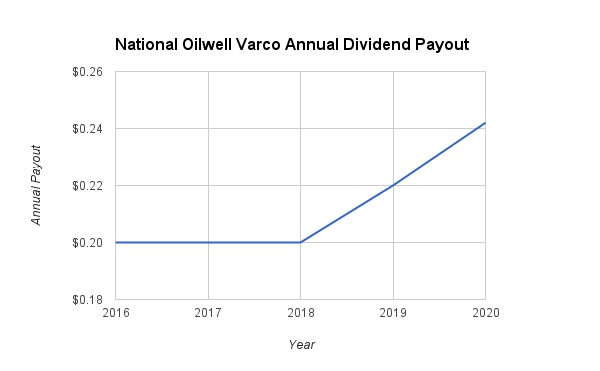The decline in oil and gas prices over the past two years has caused the U.S. energy sector a great deal of distress in that time. Oil prices, as measured by West Texas Intermediate crude, traded above $100 per barrel as recently as 2014. Since then, oil has been on a nearly unimpeded decline. While the price of oil has recovered off its February lows to its current level of $40 per barrel, that is still not at an economically viable level for many companies.
The latest victim of the oil crash is National Oilwell Varco (NOV ), which has suffered steep declines in revenue and profit over the past year. The company tried to navigate the crisis with cost cuts, but that was not enough. National Oilwell Varco lost hundreds of millions of dollars in 2015. Not surprisingly, its stock price is down significantly over the past year. On April 11, the company pre-announced that its current-quarter revenue would decline by another 20% on a quarter-over-quarter basis. NOV is burning through cash, and it resorted to leveraging up its balance with additional debt to continue paying shareholder dividends.
But that was an unsustainable situation. National Oilwell Varco responded by slashing its dividend by 89%.

Oil Collapse Causes Severe Fundamental Deterioration
National Oilwell Varco provides a wide range of products and services that are used in the oil exploration and production industry. Its business is split into four segments: rig systems, rig aftermarket, Wellbore technologies, and completion and production solutions. The company is highly exposed to the economic cycles of the exploration and production businesses. It serves primarily upstream firms, which are the hardest hit by low oil prices. As major oil producers have significantly cut back on capital expenditures in order to preserve cash during the current oil crash, weaker demand for National Oilwell Varco’s solutions has ensued.
In the fourth quarter of 2015, National Oilwell Varco’s revenue and earnings before interest, taxes, depreciation, and amortization (or EBITDA) declined 52% and 75%, respectively, year over year. For the full year 2015, the company collected $14.7 billion of revenue, down 31% year over year. It reported a net loss of $767 million for the year, or $1.99 per share, including a $1.5 billion loss in the fourth quarter alone. Its cost structure still exceeds its revenue generation with such low oil prices. The net loss for the year was a stark reversal from the previous year, in which the company earned $5.73 in profit per share.
The deterioration of National Oilwell Varco’s sales and profit was felt across its entire operating segment. All four segments posted revenue declines last year. This erosion in the company’s underlying fundamentals has had a great strain on NOV’s balance sheet. As of December 31, 2015, the company’s cash on hand was drained to $2 billion, down from $3.5 billion at the same point the previous year. Further, to keep funding its operation and its dividend, NOV took on debt; at the end of the year, National Oilwell Varco held $3.9 billion in long-term debt, up from $3 billion year over year.
Based on the 375 million shares outstanding at the end of the fourth quarter, the previous $1.84 per share annual dividend represented a burden on the company in this poor operating climate. The decision to reduce the dividend is expected to save the company approximately $615 million per year. As such, slashing the dividend is the right thing to do, and is in the long-term best interest of the company and its investors. But this was a massive cut—the new dividend level will be 5 cents per share paid quarterly, down from the previous level of 46 cents per share. The dividend yield based on the revised payout is 0.7%.
Do Not Expect Dividend Growth to Resume for Years
As a result of its fundamental declines, NOV logically had to cut its dividend in order to keep the company afloat during the crisis. The company’s fundamentals have deteriorated significantly, to the extent that investors should not expect dividend growth to resume, at least for the next year or possibly longer. Management is expecting a lower-for-longer type commodity price scenario. Unless oil prices rise rapidly, it is unlikely National Oilwell Varco will resume dividend growth until perhaps 2018. At that point, Dividend.com is projecting the company could raise its dividend by 10% per year. As the following chart indicates, its annual dividend would reach 24 cents per share by 2020, still far below its previous payout level.

The Bottom Line
The simple truth is that there was nowhere for National Oilwell Varco to hide. It has seen record low activity levels from its customers in the exploration and production industry, all of whom are slashing their capital spending budgets. National Oilwell Varco has cut costs and taken on debt to try to keep its dividend intact, but that was only a temporary solution. Cutting the dividend is the right decision. It is possible for the company to return to dividend growth if economic conditions improve later on, but investors should not expect this in the near term.





